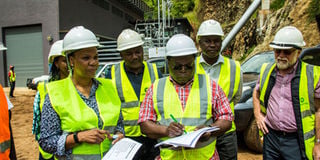Electricity distributor to build power line to industrial parks in eastern Uganda

Ms Florence Namatta Mawejje (in floral dress), and Ms Stephen Emasu (in chequered shirt), both members of Umeme Limited’s board of directors, at Siti Dam last year. FILE Photo
What you need to know:
The 33 kilovolt (kV) line from Mbale Bukwo worth $9 million (Shs33.4b) should be ready by February 2020, Ismail Musa Ladu writes.
The wavy outline of hilly lands right from Mbale to Bukwo via Kapchorwa in eastern Uganda is easy on the eye.
Through many of the hills, streams as well as two rivers meander into the valleys and lowlands.
The water whooshes as it falls from heights, beats against the rocks in its path and bounces off as tiny drops.
On River Siti in Bukwo, which is 362 kilometres East of Kampala, DI Frontiers, a developer, is working to the completion of 16.5-megawatt (MW) hydropower plant.
A grid has to be in place ahead of the commissioning of the plant.
It looks like access to power in some selected industrial parks in Eastern Uganda will be simplified if the electricity distribution company Umeme delivers its $9 million (Shs33.4billion) power line project to connect Bukwo and Mbale.
Reliable power contributes to lowering the cost of doing business in the country.
The line that could set alive the economic potentials of an enterprising district like Mbale will pick power from the 16.5-megawatt (MW) Siti II hydropower plant.
“The 33 kilovolt (kV) line we are going to construct is the one that will evacuate the power produced to, among other things, power economic development of the district and surrounding areas,” Mr Simbiso Chimbima, Umeme’s chief technical Officer, said in an interview last week.
He continued: “There also an industrial park being built in Mbale. It requires about 20MW. Until the transmission line is built, this line we are constructing will provide power to that industrial park.”
Mbale Industrial Park that is set to benefit from the project, is one of the 22 business industrial parks the government is establishing in different districts to house medium and large industries.
Saving tax payers
Once the lines have been built, government will not have to worry of drawing money from the Consolidated Fund to compensate the developer of Siti II for deemed energy. Deemed energy is the power that should have been dispatched but was not as a result of a non-existent or weak grid.
Daily Monitor understands that the $9 million (Shs33.4 billion) power project will be strung over 125 kilometres (km) from the plant to Umeme’s substation in Mbale. When asked about the commencement date, Mr Chimbima said all is set, pending the industry regulator’s approval. The power distributor will start construction once that approval is secured.
“What we are waiting for right now is a final sign-off, a no objection from Electricity Regulatory Authority. Once we get that, then we should issue the contract to the identified contractor,” Mr Chimbima said.
Daily Monitor has established through the energy ministry that the line should be ready by February 2020. This newspaper also understands that the industry regulator has no major objections to the project.
Compensation
Currently, surveyors are already on the ground doing strip mapping, which involves obtaining drawings of the sizes of each plot where the line will pass, the plots’ exact measurements and their owners.
The mapping will go on for the next three weeks after which the utility company could start compensating the Project Affected Persons (PAPs).
So far, at least 1, 300 Project Affected Persons have been identified and it is projected that slightly more than $1 million (Shs3.7 billion) will be spent in compensation.
Construction will involve, among others, the erection of the poles and stringing of the wires, importation of the substation equipment and fitting of the capacitor banks.
Capacitor banks, according to Mr Job Watti, the project manager, are used to stabilise the voltage to reduce energy losses and brownouts.
“So that is why we are introducing the equipment which bring into the network another form of reaction that enables that power to travel from Siti II and arrive in Mbale when it is at the required voltage,” he said.
132kV line
Aside from the line, government plans to construct a 132kV line between Mbale and Bulambuli. Once the 132KV line and associated substation are in place, the 33kV line Umeme would have constructed from Bukwo to Mbale will plug into the 132KV substation. Uganda’s installed electricity generation capacity has increased from 872MW in 2012 to 1,179MW (2019).
On the other hand, peak demand has increased from 450MW to 656MW over the same period. To increase the consumption of power, the government is now emphasising the expansion of the grids, connecting more premises and industrialisation.
The goal is to connect 300,000 households to the distribution network annually, starting November 2018 to 2027. This should increase the national access level from 27 per cent (2017, World Bank figure) to 60 per cent by 2027.
The government projects that will increase domestic consumption of electricity by 500MW over the same period.
Connections to grid
According to the budget speech delivered by finance minister Matia Kasaija last week on Thursday, national grid electricity connections have increased to 1.3 million customers. The rural electrification access rate has risen from 1 per cent in 2001 to over 13 per cent in 2019.




